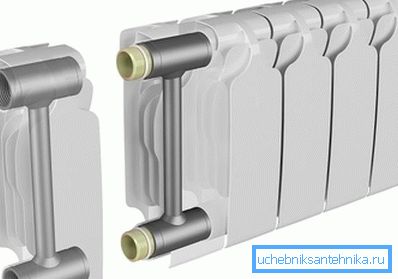How many kw in the radiator: calculations, the number of
In order for the heating of the home to be effective, one should buy its quality elements. Before this - to carry out the correct calculation of their power.

Calculations are made taking into account:
- the area of the room;
- the height of its ceiling;
- the number of windows
- the length of the room;
- climate features in the region.
You can calculate the performance of devices yourself. To do this, you need to know how many kW in 1 section of aluminum radiator or cast iron, steel, bimetallic counterpart.
Right choice
- The performance of heating devices should be 10% of the area of the room, if the height of its ceiling is less than 3 m.
- If it is higher, then add 30%.
- For the end room it is necessary to add another 30%.
Estimated calculations

After determining the heat loss, it is necessary to determine the performance of the device (how many kW in a steel radiator or other devices should be).
- For example, it is necessary to heat a room with an area of 15 m? and a ceiling height of 3 m.
- We find its volume: 15 • 3 = 45 m ?.
- The instruction says that for heating 1 m? in conditions of Central Russia, it is necessary to produce 41 W of thermal performance.
- This means that we multiply the volume of the room by this number: 45 • 41 = 1845 W. This power should have a radiator.
Note! If the dwelling is located in a region with severe winters, the resulting figure should be multiplied by 1.2 (heat loss coefficient). The total figure will be 2214 watts.
Number of ribs
Next, you need to calculate the number of sections in the battery. The instructions for the products indicate the parameter of each edge.
From it you will learn how many kW in one section of a bimetallic radiator and an aluminum counterpart is 150-200 watts. Take the maximum parameter and divide it into the total required power in our example: 2214: 200 = 11.07. So, for heating the room need a battery of 11 sections.
Thermal power

In the room, heating devices are placed against the outer wall under the window opening. As a result, the heat radiated by the device is optimally distributed. The cold air coming from the windows is blocked by a heated stream going up from the radiator.
Cast iron batteries
Pig-iron analogs have such advantages:
- possess a long operational resource;
- have a high level of strength;
- they are resistant to corrosion;
- Excellent for use in utility systems operating on low-quality coolant.
- Now manufacturers produce cast-iron batteries (their price is higher than conventional counterparts), having an improved appearance, thanks to the use of new technologies for casting their casings.
Disadvantages of products: a large mass and thermal inertia.
The lower table voices how many kW in a cast iron radiator, based on its model.
| Radiator model | Thermal power of one section in watts |
| MS-140 / M-2 | 160 |
| MS-140 / M-300 | 117 |
| MS-90 | 130 |
| T-90 / M | 127 |
Note! To heat a room with an area of 15 m ?, power, that is, kW of a cast iron radiator, must be at least 1.5. In other words, the battery should consist of 10-12 sections.
Aluminum radiators

Aluminum products have a greater thermal capacity than analogs of cast iron. When asked how many kW in one section of the aluminum radiator, the experts answer that it reaches 0.185-0.2 kW. As a result, 9-10 sections of aluminum sections will be enough for a standard heating level of a fifteen-meter room.
The advantages of such devices:
- a light weight;
- esthetic design;
- high heat transfer rate;
- The temperature can be controlled with the help of thermostatic valves.
But products from aluminum do not have such strength as analogs of cast iron, for example, an oil cooler of 2 kW. Therefore, they are sensitive to surges in the working pressure in the system, hydraulic shocks, excessively high temperature of the heat carrier.
Note! When the water pH level (acidity) is high, aluminum gives off a lot of hydrogen. This negatively affects our health. On this basis, it is desirable to use such devices in a heating system in which the coolant has a neutral acidity.
Bimetallic products

Before finding out how many kW in 1 section of a bimetallic radiator, it should be taken into account that such batteries have similar operational parameters with aluminum analogues. However, they have no disadvantages peculiar to them.
This circumstance determined the design of the devices.
- They consist of copper or steel pipes through which coolant flows.
- The tubes are hidden in an aluminum plate housing. As a result, the water circulating inside does not interact with the aluminum of the case.
- On this basis, the acid and mechanical characteristics of the heat carrier do not affect the operation and condition of the device in any way.

Thanks to steel pipes, the fixture has high strength. The increased heat transfer is provided by external edges from aluminum. Trying to find out how many kW in a steel radiator, note that the bimetal has the highest heat transfer - about 0.2 kW per edge.
Conclusion
Finding out how many kW in 1 section of a steel radiator or equivalent from another metal, you can calculate the heat transfer of the purchased products. This will allow you to equip an efficient heating system in your home.
The video in this article continues to visually inform you on the topic.